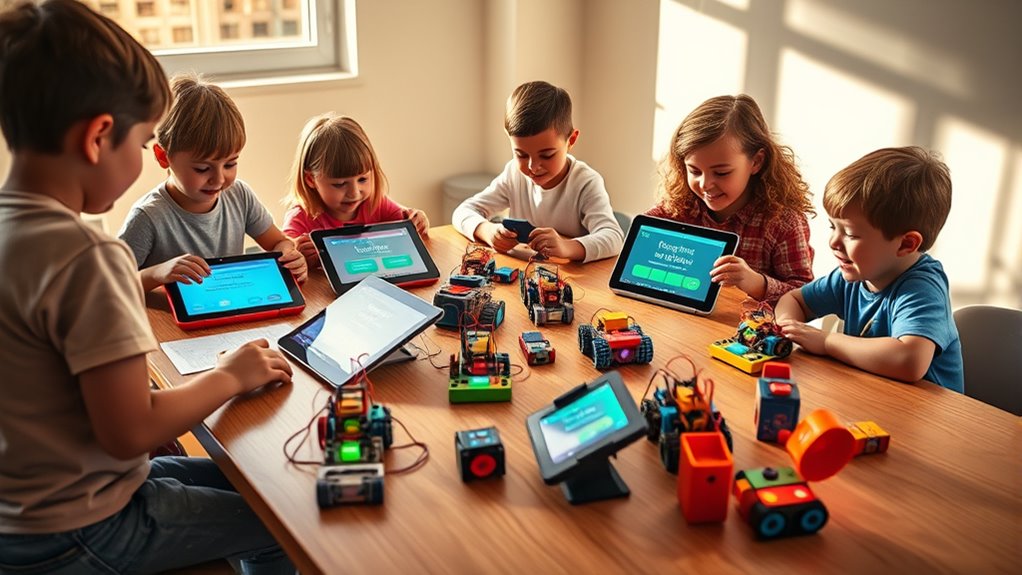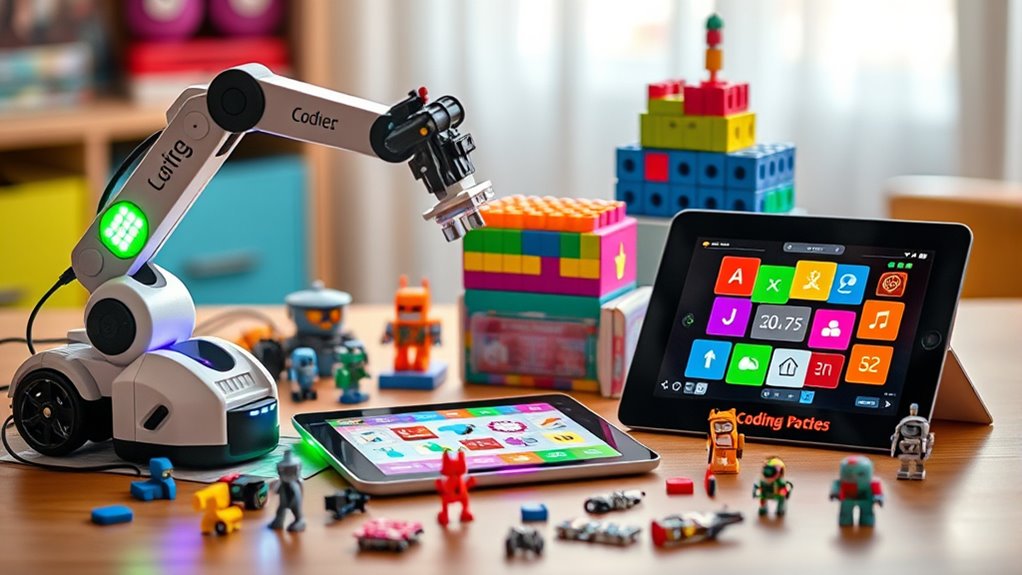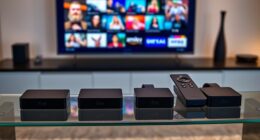If you’re looking for the top coding toys to boost kids’ creativity and learning in 2025, there’s a great mix of options. From robot kits that support drag-and-drop Scratch to advanced AI robots like Nous AI, there’s something for every age and skill level. Plus, STEM building sets and screen-free activity toys make learning engaging and hands-on. Keep exploring, and you’ll discover the best tools to inspire young inventors and problem-solvers.
Key Takeaways
- The list features a variety of coding toys, from beginner-friendly screen-free kits to advanced robotics for teens.
- It emphasizes toys that promote hands-on learning, creativity, problem-solving, and STEM skill development.
- Includes options supporting both block-based and text-based coding, suitable for different age groups and skill levels.
- Highlights toys with interactive features like sensors, AI, and robotics to deepen engagement and learning.
- Focuses on toys that foster family bonding, independent exploration, and prepare kids for future tech careers.
Q-Scout STEM Projects for Kids
Are you looking for a fun and educational way to introduce kids aged 8-12 to programming and robotics? Q-Scout STEM projects make learning engaging and easy. Kids start with drag-and-drop Scratch, then advance to Arduino and Python, building their coding, electronics, and robotics skills. The robot offers four modes: remote control, obstacle avoidance, music, and route following, sparking imagination and focus. With simple 30-minute assembly and customizable parts, children develop hands-on skills and creativity while bonding with parents. Made from durable, high-quality materials, Q-Scout is perfect for indoor and outdoor play, making learning both fun and long-lasting.
Best For: children aged 8-12 and their parents seeking an engaging, educational robotics and programming experience that combines hands-on building with creative exploration.
Pros:
- Teaches programming, electronics, and robotics through a simple, step-by-step process starting with Scratch and advancing to Arduino and Python.
- Offers multiple interactive modes such as remote control, obstacle avoidance, music playback, and route following to stimulate imagination and focus.
- Easy 30-minute assembly with detailed instructions and customizable parts encourages hands-on skills and family bonding.
Cons:
- May require parental assistance for younger children or those new to electronics and programming.
- Limited advanced features for older or more experienced robotics enthusiasts.
- Dependence on additional electronic modules from Robobloq for full customization, which may involve extra cost.
Nous AI Robot for Kids Ages 12+ STEM Coding Robot Kit
The Nous AI Robot by MatataStudio is an excellent choice for kids aged 12 and up who are enthusiastic to plunge into AI, robotics, and coding. This STEM kit offers hands-on learning with AI concepts, machine learning, neural networks, and computer vision, all accessible through Scratch and Python. It’s easy to assemble, inspiring creativity through electronics and robotics projects. The platform, Nous.MatataStudio, provides beginner-friendly tutorials and advanced tools for data training and AI deployment. Whether for school, homeschooling, or competitions, this versatile robot sparks curiosity, deepens understanding, and develops essential STEM skills that grow with your child’s interests.
Best For: Kids aged 12 and up interested in exploring AI, robotics, and coding through hands-on STEM projects in educational, homeschooling, or competition settings.
Pros:
- Supports both Scratch and Python programming, catering to different skill levels
- Includes comprehensive, easy-to-follow assembly instructions and tutorials
- Integrates advanced AI technologies like machine learning, computer vision, and speech recognition for practical learning
Cons:
- May require adult supervision during assembly for younger or less experienced children
- Advanced features might be challenging for complete beginners without prior coding experience
- The platform relies on internet connectivity, which could be a limitation in some environments
Engino STEM Toys: Inertia, Friction, Circular Motion Educational Construction Kits
Kids fascinated by science and engineering will find Engino STEM Toys especially rewarding, as they combine hands-on construction with a clear focus on fundamental physics concepts like inertia, friction, and circular motion. This set includes six models, such as a rocket launcher and crash test rig, that demonstrate these principles in action. Designed for kids 9 and up, it promotes creativity and critical thinking while making complex physics accessible. The kit features printed instructions, theoretical facts, and an interactive VR app for virtual building. Highly rated by users, it offers an engaging way to explore science through functional models that encourage active experimentation and learning.
Best For: young science enthusiasts aged 9 and up who want to explore physics concepts through hands-on building and interactive learning.
Pros:
- Combines educational theory with practical model building to enhance understanding of inertia, friction, and circular motion.
- Includes detailed printed instructions, scientific facts, experiments, and an interactive VR app to support varied learning styles.
- Highly rated for both fun and educational value, making it an engaging STEM activity for children and as a gift.
Cons:
- Digital resources like the VR app may require additional devices or have language limitations, limiting accessibility for some users.
- Younger children (below age 9) may find the instructions challenging without adult assistance.
- Some users prefer printed instructions over digital or app-based guides for ease of use during the building process.
Educational Board Game for Kids Teaching AI and Programming
Looking for an engaging way to introduce children to AI and programming? Coder Mindz is a groundbreaking STEM board game designed for kids 6 and up, making complex AI concepts fun and accessible. Created by 9-year-old Samaira, it’s used in over 600 schools worldwide and features gameplay that teaches image recognition, training, inference, and autonomous systems. The game incorporates coding fundamentals like loops, functions, and conditionals through interactive challenges. Its flexible design suits all skill levels, making it perfect for home, school, or camps. Kids quickly grasp core ideas while developing strategic thinking, problem-solving, and collaboration skills—all while having a blast.
Best For: educators, parents, and kids aged 6+ seeking an engaging, hands-on way to introduce AI and programming concepts through a versatile and interactive STEM board game.
Pros:
- Simplifies complex AI and coding principles making them accessible for young children
- Supports multiple skill levels and adaptable gameplay for diverse learning environments
- High-quality components and engaging design foster enthusiasm, strategic thinking, and collaboration
Cons:
- Some users have noted minor errors in certain cards, such as loop conditions
- May require adult facilitation for younger children to maximize understanding
- As a physical game, it may be less suitable for remote or virtual learning environments
Mech 5, Mechanical Coding Robot
Ever wondered how to make learning about robotics both fun and hands-on? The Mech 5 Mechanical Coding Robot is perfect for that. Designed for kids 10 and up, it combines mechanical engineering with coding through simple, snap-on buttons. Kids can make it throw, lift, kick, or draw—seeing their commands come to life instantly. Its modular design encourages assembly and customization, fostering creativity and problem-solving. With the core idea, “Build it. Code it. Watch it move,” this robot turns learning into a dynamic, engaging experience. It’s a fantastic way to introduce young learners to STEM fundamentals while having a blast.
Best For: young aspiring engineers aged 10 and above who enjoy hands-on STEM activities involving mechanical design and coding.
Pros:
- Interactive and engaging, allowing kids to see immediate results from their coding commands
- Modular design encourages creativity, assembly, and customization
- Promotes learning of mechanical engineering principles and coding in a fun, practical way
Cons:
- Limited to basic mechanical movements, which may not suit advanced robotics learners
- Requires adult supervision for assembly and safe use of small parts
- Might be less suitable for children under 10 due to the complexity of some tasks
Learning Resources Botley Coding Robot STEM Toy (45-Piece Set, Ages 5+)
The Learning Resources Botley Coding Robot STEM Toy is an ideal choice for young children aged 5 and up who are just beginning to explore coding and problem-solving. This 45-piece set includes a remote programmer, maze components, obstacle pieces, coding cards, and more, all designed for active, screen-free play. Botley’s smart logic allows kids to program it for up to 80 steps, with features like obstacle avoidance and line-following. It fosters creativity, critical thinking, and early STEM skills while being easy to set up and use. Though some features may require patience, parents love its engaging, hands-on approach to introducing coding concepts in a fun, accessible way.
Best For: young children aged 5 and up who are beginning to learn coding and problem-solving through active, screen-free play.
Pros:
- Encourages creativity, critical thinking, and early STEM skills with engaging activities
- Easy to set up and operate, suitable for independent learning and fun exploration
- Provides a variety of interactive features like obstacle avoidance, line-following, and looping commands
Cons:
- Some features like object detection and line following can be finicky and surface-dependent
- Rapid battery consumption may require frequent replacements or alternative power solutions
- Limited suitability for multiple children playing simultaneously due to its design and interaction style
Playz Coding & Computer Science Kit for Kids
If you’re searching for an engaging way to introduce young children to computer science, the Playz Coding & Computer Science Kit for Kids is an excellent choice. This hands-on kit makes learning core concepts like binary code, encryption, and algorithms fun and accessible without electronics. With over 30 tools and a colorful instruction guide, kids can create binary necklaces, mystery mazes, and pixelated images, developing problem-solving and fine motor skills. It’s suitable for children aged 6 and up and promotes curiosity, critical thinking, and collaboration. Many parents and educators appreciate its quality, all-encompassing content, and ability to make complex STEM ideas easy to understand.
Best For: young children and beginners aged 6 and up who want to learn fundamental computer science concepts through hands-on, non-electronic activities.
Pros:
- Engages kids with fun, interactive projects that teach binary code, encryption, and algorithms.
- Includes comprehensive, easy-to-follow instructions and over 30 tools, making learning accessible.
- Promotes critical thinking, problem-solving, fine motor skills, and collaboration in a safe, electronic-free environment.
Cons:
- May require adult supervision or assistance for younger children to fully understand complex concepts.
- Limited to physical activities; may not fully replicate digital coding experiences.
- Some users might find the set’s content repetitive after multiple uses, requiring additional activities for sustained interest.
Makeblock mBot Robot Kit with Scratch Coding for Kids
Looking for a coding toy that combines hands-on building with beginner-friendly programming? The Makeblock mBot Robot Kit with Scratch Coding is perfect for kids aged 8-12. It offers engaging STEM learning through simple assembly and fun projects like obstacle avoidance and line-following. The kit features clear instructions, durable parts, and supports kids as they progress from block-based coding to Arduino. Kids can experiment with sensors, LEDs, and motors, fostering creativity and problem-solving. With positive reviews for its quality and educational value, the mBot makes an excellent gift for young robotics enthusiasts enthusiastic to explore coding and electronics.
Best For: kids aged 8-12 who are interested in hands-on STEM learning, robotics, and beginner-friendly coding projects.
Pros:
- Easy to assemble with comprehensive instructions, making it suitable for beginners.
- Supports progressive learning from block-based Scratch coding to Arduino programming.
- Durable, high-quality parts that promote active play and long-lasting use.
Cons:
- Some users find the programming software updates and downloads challenging.
- Limited advanced challenges; more levels or complexity could enhance engagement.
- Transition from graphical coding to text-based programming could be more gradual for some learners.
Snap Circuits Jr. SC-100 Electronics Exploration Kit
Children aged 8 and up will find the Snap Circuits Jr. SC-100 Electronics Exploration Kit an engaging way to learn about electronics. It includes over 30 color-coded, real circuit parts that snap together easily, allowing kids to build more than 100 projects like sound-activated switches, musical doorbells, and voice-controlled lamps. The step-by-step manual features clear illustrations, making complex concepts accessible. This kit promotes hands-on learning, problem-solving, and creativity while teaching fundamental electronics principles without soldering. Its durable design and expandability options make it a perfect introductory tool for curious minds enthusiastic to explore technology and develop practical skills.
Best For: children aged 8 and above interested in hands-on electronics learning, problem-solving, and creative project building.
Pros:
- Easy-to-snap, color-coded components make assembly simple for beginners
- Offers over 100 engaging projects that teach fundamental electronics concepts
- Durable design with expandability options for advanced learning
Cons:
- Requires two AA batteries (not included) to operate the projects
- Limited to basic circuitry; more complex electronics require additional upgrade kits
- Some parts may be small and could pose a choking hazard for very young children
Learning Resources Code & Go Robot Mouse Activity Set
The Learning Resources Code & Go Robot Mouse Activity Set stands out as an ideal choice for young kids aged 4 and up who are just beginning to explore coding and problem-solving through hands-on play. With 83 pieces, including a programmable robot mouse, maze grids, and activity cards, it encourages critical thinking and sequencing skills without screens. Kids can design mazes, program the mouse using colorful buttons, and develop foundational coding concepts like algorithms and logic. The set’s durability and open-ended options make it perfect for classroom or home use. It builds confidence in STEM, promotes creativity, and offers endless opportunities for engaging, educational fun.
Best For: young children ages 4 and up who are beginning to learn coding, problem-solving, and critical thinking through hands-on, screen-free play.
Pros:
- Encourages foundational STEM skills like sequencing, algorithms, and spatial reasoning without screens
- Durable, versatile, and suitable for both classroom and home use with endless maze customization options
- Promotes creativity, strategic thinking, and confidence in early coding and problem-solving abilities
Cons:
- May be challenging for children under age 5 to assemble or program independently
- Occasional inaccuracy of the robot mouse or need for batteries can disrupt play sessions
- Limited complexity for older children seeking more advanced coding challenges
KEYESTUDIO Smart Car Robot 4WD Programmable DIY Kit for Arduino
If you’re introducing teens or even older kids to robotics and programming, the KEYESTUDIO Smart Car Robot 4WD DIY Kit for Arduino is an excellent choice. It includes sensors like IR, Sonic, Bluetooth, and a dot matrix display, enabling features such as obstacle avoidance, line tracking, auto-follow, and remote control. The kit comes with detailed modular instructions and all necessary parts, making it easy to assemble and learn. While software setup can be tricky, especially with Bluetooth and driver issues, the included code and resources help users get started. It’s a fantastic way to explore electronics, coding, and sensor integration hands-on.
Best For: teens and adults interested in learning robotics, electronics, and programming through hands-on DIY projects with sensor integration.
Pros:
- Includes comprehensive sensors like IR, Sonic, Bluetooth, and dot matrix display for diverse functionalities
- Detailed modular instructions and all necessary parts facilitate easy assembly and learning
- Robust build quality with high-quality components suitable for educational and hobbyist use
Cons:
- Software setup and Bluetooth connectivity can be challenging, especially on modern Windows systems
- Outdated instructions and driver issues may hinder quick start and troubleshooting
- Some users experience motor response problems or difficulty uploading code despite successful assembly
Kids Touch Screen Smart Watch with 26 Games and Camera for Boys
A kids touch screen smart watch with 26 games and a camera is an excellent choice for parents seeking a versatile device that combines fun and learning. I love how it offers educational tools like puzzles, audiobooks, and learning cards that boost logical thinking and creativity. The camera encourages kids to explore photography, while features like a pedometer promote active play. Its durable design and simple interface make it easy for children to navigate. Plus, parental controls ensure safe usage. With a long-lasting battery and customizable themes, this smartwatch keeps kids engaged all day, making it a perfect blend of entertainment and educational value.
Best For: parents looking for a safe, educational, and entertaining smartwatch for children aged 3-13 to promote active play and learning.
Pros:
- Multifunctional with 26 educational games, camera, audiobooks, and learning tools.
- Durable design with a user-friendly interface suitable for small hands.
- Long battery life up to 10 days and parental controls for safe usage.
Cons:
- Limited media storage capacity of approximately 479MB, restricting downloads.
- Soft, non-replaceable band may wear out over time.
- Adapter not included with the USB-C charging cable, requiring an additional purchase.
Science Kits for Kids Age 4-12 with 90 Science Experiments
For parents and educators seeking an extensive STEM activity, this science kit offers over 90 experiments designed to ignite curiosity and foster hands-on learning. I love how it includes engaging experiments like volcanic eruptions, fizzy reactions, and magic potions, perfect for kids aged 4-12. The kit provides clear electronic instructions with illustrations, making it easy for children to follow along independently or with supervision. Safe and high-quality materials meet US standards, ensuring worry-free fun. Whether as a gift or educational tool, it encourages creativity, critical thinking, and scientific exploration, making science exciting and accessible for young learners.
Best For: parents, teachers, and caregivers seeking a comprehensive, engaging STEM activity set for children aged 4-12 to foster curiosity and hands-on scientific learning.
Pros:
- Includes over 90 fun and educational experiments to keep children engaged for months
- Clear electronic instructions with illustrations make it easy for kids to follow independently or with supervision
- High-quality materials meeting US safety standards ensure safe and worry-free play
Cons:
- Some users have reported missing ingredients in certain sets
- The large number of experiments may be overwhelming for very young children without adult assistance
- The kit’s size and weight might be less convenient for travel or on-the-go use
STEM Science Kits for Kids Ages 8-12
STEM science kits for kids aged 8-12 are an excellent choice for young explorers enthusiastic to develop their engineering and problem-solving skills. I love how these kits let children build six different models, like a Space Station, Rover, or Space Shuttle, sparking creativity and curiosity about space. They promote hands-on learning, improve spatial awareness, and challenge kids with progressive tasks. Powered by solar energy or rechargeable batteries, the kits teach eco-friendly concepts while being fun to assemble. With clear instructions and durable, non-toxic parts, these kits are safe and perfect for independent or family projects, making them a fantastic gift for future scientists.
Best For: young children aged 8-12 who are interested in exploring space, engineering, and renewable energy through hands-on STEM activities.
Pros:
- Encourages creativity, problem-solving, and critical thinking skills.
- Includes multiple models like Space Station, Rover, and Shuttle to spark curiosity.
- Eco-friendly design powered by solar energy or rechargeable batteries promotes environmental awareness.
Cons:
- Assembly may be challenging for some younger children without adult assistance.
- Requires batteries or solar power, which may need replacement or charging over time.
- Might be limited in complexity for older or more experienced young engineers.
Learning Resources Rechargeable Code & Go Robot Mouse for Kids
The Learning Resources Rechargeable Code & Go Robot Mouse is an excellent choice for young children just starting to explore coding, thanks to its simple, intuitive design. I love that kids can program it using colorful, matching buttons and pictorial coding cards, making it accessible for beginners. The rechargeable feature means no more batteries, and its compact size makes it perfect for various play areas. Kids can create mazes, practice sequencing, and learn cause-and-effect through engaging activities. This toy promotes problem-solving and critical thinking while being fun and easy to use, making it a fantastic introduction to STEM concepts for early learners.
Best For: young children and beginners interested in learning basic coding and problem-solving skills through fun, hands-on activities.
Pros:
- Easy-to-use and intuitive design with colorful buttons and pictorial coding cards that facilitate beginner programming.
- Rechargeable feature eliminates the need for frequent battery replacements, making it more convenient and cost-effective.
- Supports diverse learning environments with adjustable maze complexity and engaging activities that promote critical thinking.
Cons:
- Some users report limited turning capabilities, which may affect maze navigation.
- The price point around $45 may be considered high for some budgets.
- Occasional issues like the mouse spinning in circles can impact the overall play experience.
Factors to Consider When Choosing Coding Toys for Kids

When selecting coding toys for kids, I consider several key factors to guarantee they’re a good fit. I look at the child’s age and skill level, how educational and engaging the toy is, and whether it’s safe and durable for regular use. Additionally, I check if the toy can grow with them through expandability and if it’s easy to assemble out of the box.
Age-Appropriate Complexity
Choosing the right coding toy depends heavily on matching the complexity of the activities to a child’s developmental stage. For younger kids aged 4-7, look for toys with simple drag-and-drop interfaces that introduce basic concepts like sequencing and logic without overwhelming them. As children grow older, around 8-12, they can handle more advanced programming that challenges their problem-solving skills. It’s important to select toys with adjustable difficulty levels or features that expand, so the toy can grow with their abilities. The interface should have clear visuals and straightforward instructions to prevent frustration. Balancing educational challenge with fun is key—avoid overly complex systems that might discourage beginners, and ensure the toy remains engaging as their skills develop.
Educational Value Focus
Since selecting a coding toy that offers strong educational value is vital, I focus on options that teach core programming concepts like sequencing, loops, conditionals, and algorithms. These fundamentals create a solid foundation for future learning. I also look for kits with hands-on activities and real-world applications, which help kids understand STEM principles through practical experimentation. It’s important that the toy offers progressive difficulty or expandability, so children can build on their skills over time. Clear instructions and age-appropriate explanations are essential to ensure kids grasp key concepts easily. Finally, I prioritize toys that integrate science, technology, engineering, and math topics, fostering comprehensive STEM literacy alongside coding skills, making learning both engaging and meaningful.
Safety and Durability
Ensuring safety and durability is essential when selecting coding toys for kids, as these factors directly impact their well-being and the toy’s longevity. I recommend choosing toys made from non-toxic, BPA-free materials to keep children safe during play. Sturdy construction with reinforced parts helps withstand rough handling and prevents breakage, which is crucial for active kids. For younger children, secure attachment of small or removable components is vital to eliminate choking risks. Additionally, verifying compliance with safety standards like ASTM, CE, or CPSIA ensures the toy meets electrical and mechanical safety requirements. Durable design features, such as impact-resistant casings and high-quality buttons, contribute to long-lasting use. Prioritizing these safety and durability aspects guarantees a worry-free and enjoyable learning experience for kids.
Expandability Options
When selecting coding toys for kids, considering expandability options can considerably extend their value and educational potential. Toys with modular components or upgrade kits allow children to build on their initial projects, encouraging ongoing learning and creativity. Compatibility with other kits or platforms can also increase a toy’s lifespan, enabling integration with new parts or coding environments as skills grow. Additionally, many toys offer software updates that introduce new challenges, levels, or features, keeping kids engaged over time. The ability to customize or add electronic modules ensures that the toy remains relevant as children develop their interests and abilities. Overall, expandability options make coding toys more versatile, future-proof, and better suited to fostering continuous exploration and skill development.
Ease of Assembly
Choosing coding toys for kids becomes easier when you prioritize ease of assembly, as it directly impacts their engagement and confidence. Look for toys with clear, detailed instructions and visual guides that make building straightforward. Kits that require minimal tools or specialized skills—preferably with snap-on parts or pre-labeled components—help kids assemble quickly and independently. Consider products designed with step-by-step processes tailored to the child’s age and skill level, ensuring a smooth experience. Modular and reusable parts make setup and adjustments effortless, keeping the focus on learning and fun. Additionally, choose kits that include all-encompassing, user-friendly manuals or digital instructions. These features reduce frustration and make independent construction achievable, fostering a sense of accomplishment and encouraging continued interest in coding.
Technological Compatibility
Have you checked if the coding toy works smoothly with the devices your child already uses? Compatibility is key to ensuring seamless connectivity and easy programming. Verify that the toy supports popular platforms like Scratch, Python, or Arduino, which can expand learning opportunities. It’s also important to confirm compatibility across different operating systems, such as Windows, macOS, iOS, and Android, so your child can use it on their preferred device. Make sure the software or app receives regular updates to avoid obsolescence, and check if the hardware interfaces—like USB, Bluetooth, or Wi-Fi—align with your devices. Ensuring these factors will make coding sessions more enjoyable and effective, preventing frustrations and maximizing your child’s engagement with their new coding toy.
Budget Considerations
Budget considerations are essential to guarantee you select a coding toy that provides value without overspending. First, set a clear budget range to narrow your options and prevent impulse buys. It’s important to evaluate the cost-to-educational-value ratio, ensuring the toy offers meaningful learning within your price point. Keep in mind that advanced robotics kits with features like AI or programmable sensors often cost above $100, which may be beyond some budgets. Luckily, there are plenty of affordable options under $50 that still promote hands-on coding and STEM skills. Be aware that additional costs, such as batteries, accessories, or expansion kits, can add up quickly, so factor those into your overall budget to avoid surprises. Being mindful of these factors helps you find a quality toy that balances cost and learning potential.
Frequently Asked Questions
What Safety Features Should I Look for in Coding Toys for Young Children?
Imagine giving your child a treasure chest—safety features are the lock ensuring only trusted hands can access it. When choosing coding toys, I look for rounded edges, non-toxic materials, and secure batteries to prevent choking hazards. I also check for age-appropriate warnings and sturdy construction. These features act like a safety net, giving both of us peace of mind while kids explore and learn confidently.
Are There Coding Toys That Support Multiple Programming Languages?
You asked if there are coding toys that support multiple programming languages. I’ve found that some advanced toys, like little programmable robots and coding kits, do offer support for several languages such as Scratch, Python, or JavaScript. These toys are great for kids ready to explore more complex coding concepts. They provide flexibility and help children develop skills in different programming environments, making learning both fun and versatile.
How Do Coding Toys Adapt to Different Skill Levels?
You’re wondering how coding toys adapt to various skill levels. I find that many toys are designed with adjustable difficulty settings or multiple programming modes, allowing beginners to learn foundational concepts and advanced users to challenge themselves. Some toys also offer step-by-step tutorials or gamified progressions, which help kids grow their skills gradually. This flexibility keeps learning engaging, ensuring every child can find a suitable starting point and advance at their own pace.
Can Coding Toys Be Used for Remote or Online Learning?
Absolutely, coding toys are great for remote or online learning. I’ve seen kids easily connect with interactive platforms and apps that come with these toys, making learning engaging even from home. They often include tutorials, challenges, and virtual support, which helps kids stay motivated and progress at their own pace. Plus, parents and teachers can monitor progress remotely, making these toys versatile tools for digital education.
What Are the Best Ways to Integrate Coding Toys Into Classroom Activities?
This question is incredibly important because integrating coding toys into classroom activities can revolutionize how students learn tech skills. I recommend starting with hands-on projects where students collaborate, making coding toys part of group challenges or competitions. Use them to reinforce lessons, spark curiosity, and encourage problem-solving. By embedding these toys into daily routines, you’ll see engagement skyrocket—turning your classroom into a hub of innovation and excitement!
Conclusion
As I picture a child’s face lighting up while guiding a robot through a maze or watching a colorful circuit come to life, I realize these toys do more than teach—they ignite a spark of curiosity. Choosing the right coding toy is like planting a seed for future innovation. With the right tools, your kid’s imagination can soar like a rocket, turning dreams into dazzling realities in the vibrant world of STEM.










